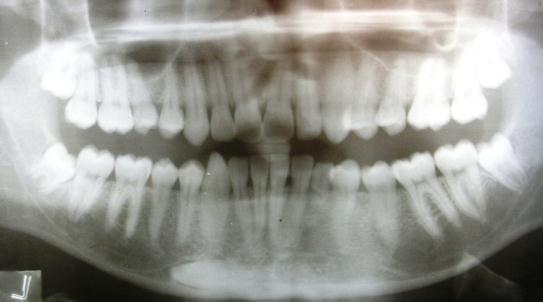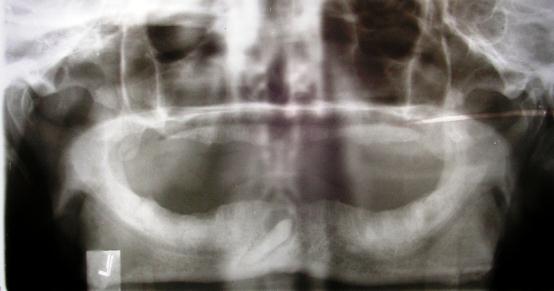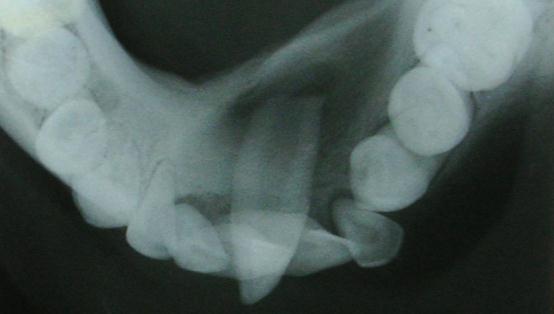Unusual intraosseous transmigration of impacted tooth - report of three cases
International Journal of Oral & Maxillofacial Pathology. 2012;3(3):56-60
ISSN 2231 – 2250
Available online at http://www.journalgateway.com or www.ijomp.org
Case Report
Intraosseous Transmigration of Impacted Canines: Report of Five Cases
Sulabha AN, Sachin Deshpande, Sameer C
Abstract
Transmigration is rare and unusual anomaly involving the intraosseous migration of impacted
tooth across midline regardless of the distance. This occurs almost exclusively with mandibular
canines. Etiology is still unclear and is not well documented in the literature. Transmigration can
occur as isolated finding or in association with other findings such as dentigerous cyst,
odontomas, impactions of other teeth etc. Transmigrated canines are particularly significant due
to aesthetic and functional importance. Early radiographic examination of the patient is important
for the treatment. More documentation of this anomaly and future studies may lead to a better
understanding of this rare anomaly, its etiology and improvement of the classification criteria. This
paper presents five cases of transmigration of mandibular canines of which two were associated
with dentigerous cyst, one associated with bodily rotation of canine, one associated with absence
of third molars on right side.
Keywords: Impacted Canine;Tooth Migration;Transmigration;Intraosseous;Dentigerous Cyst;
Observation.
Sulabha AN, Sachin Deshpande, Sameer C. Intraosseous Transmigration of Impacted Canines: Report of
Five Cases. International Journal of Oral and Maxillofacial Pathology; 2012:3(3):56-60. International
Journal of Oral and Maxillofacial Pathology. Published by Publishing Division, Celesta Software Private
Limited. All Rights Reserved.
Received on: 16/06/2012 Accepted on: 09/09/2012
Introduction
Since impacted or transmigrated teeth are
Impacted teeth are important in dentistry and
important especially in terms of orthodontic
are particularly significant in orthodontics,
treatment planning, these teeth must be
especially if the impacted tooth is a canine.
diagnosed clinically and radiographically.
The occurrence of impacted mandibular
Early diagnosis with timely treatment can
canine is rarer than maxillary canine and it is
help dentist preserve the canines, which
even rarer phenomenon when such an
play an important role in both aesthetics and
impacted mandibular canine migrates to the
function in human dentition.2 Future studies
other side of mandible crossing the midline.1
and more documentation of this anomaly
This rare phenomenon of the tooth crossing
may lead to it's inclusion as one of
developmental anomalies of teeth and better
understanding of this rare condition.5
exclusively with mandibular canines2 with an
incidence of 0.1%.3
The present paper reports five cases of
transmigrated canines of which two were
The exact mechanism of transmigration is
associated with dentigerous cyst, one with
not clear.2 This anomaly is most often
absence of two third molars, other was
associated with bodily rotated lower canine
pathology, and usually cannot be detected
in mesiodistal direction.
during the routine clinical examination.
Case Report:
discovered on routine intraoral periapical
view because the tooth is most frequently
The 22 year old male reported to department
horizontally impacted under the apices of
of oral medicine with a complaint of retained
permanent teeth adjacent to the mandibular
mandibular right and left primary canine.
border. Similarly a palatally impacted canine
Intraoral examination showed absence of
is sometimes horizontal positioned very high
both permanent lower canines and retained
in the palatal vault, close to the floor of nasal
both lower primary canines. Panoramic view
cavity and thus might not be detected.
Therefore when any permanent tooth is
canines to be impacted. The right and left
mandibular canines were unerupted and
both were mesioangularly impacted with the
left canine crossing the midline and the right
2012 International Journal of Oral and Maxillofacial Pathology. Published by Publishing Division, Celesta Software Private Limited. All Rights Reserved




ISSN 2231 – 2250
Intraosseous Transmigration of Impacted Canines. 57
canine positioned very close to the midline.
completely edentulous. The panoramic
Right upper and lower third molars were
radiograph indicated the left mandibular
absent. There was no pathologic finding
canine was impacted mesioangularly with
associated with both impacted canines. The
part of crown crossing the midline. The
patient was asymptomatic and was informed
crown of this canine was surrounded by a
of the condition and radiographic monitoring
cystic radiolucency (Fig 3). Patient was
was strongly recommended (Fig 1).
treated by surgical removal of cyst along
with the involved tooth and histopathological examination confirmed the cyst to be dentigerous cyst.
showing the both the mandibular left canine
crossing the midline and right canine close
showing the left mesioangularly impacted
canine surrounded by a cystic cavity.
A 24 years old male reported to the
department of Oral Medicine for oral
A 17 years male reported to department of
prophylaxis. Intraoral examination revealed
oral medicine with a complaint of swelling in
absence of right permanent mandibular
the lower front of jaw. Intraoral examination
canine and retention of right mandibular
revealed a nontender, slightly firm swelling
primary canine. Radiographic examination
in the left side of lower jaw with the
impacted right canine at the inferior border
of the mandible with its crown positioned
below the root apices of right premolars.
mandibular canine across the midline and
Bodily rotation of left canine in mesiodistal
was associated with radiolucency along with
direction was seen along with impaction of
buccal cortical plate expansion suggestive of
all the third molars (Fig 2). Patient was
dentigerous cyst (Fig 4). Surgically the cyst
informed of the condition and regular
was enucleated along with the removal of
radiographic follow up was advised.
histopathological
examination confirmed the lesion to be dentigerous cyst.
showing horizontally impacted canine of
right side near inferior border of mandible
below the apices of premolar.
showing impacted canine crossing the mid
line and associated with large cystic space.
A 69 years male reported to department of
oral medicine for construction of prosthesis.
A 12 years old male child reported to
Intraoral examination revealed slight bulge in
department of oral medicine with a complaint
the lower anterior region. Patient was
of decayed tooth in right lower back region.
58 Sulabha AN et al.,
ISSN 2231 - 2250
possible to decide whether pathological
mesioangular impaction of left canine below
the apices of the left incisors with it's
transmigration of the teeth or not.5 Aydin and
follicular space just touching the midline.
According to Howard's criteria complete
transmigration associated with dentigerous
transmigration was expected. Patient was
cyst. Transmigration is also associated with
informed of the condition and radiographic
other pathological conditions such as
follow up was advised.
odontomas, hypodontia, impaction of other
teeth3,6. The other suggested etiologies are
Discussion
premature loss of deciduous teeth, retention
of deciduous teeth, inadequate space,
phenomenon.3 The term transmigration was
first used by Ando et al in 1964. Tarsitano et
unfavorable alveolar length, genetics, root
phenomenon of an unerupted mandibular
stump obstacle would be sufficient to divert
canine the midline. Joshi and Acluck et al
a tooth from its original path of eruption.6,9,10
suggested that the tendency of a canine to
Howard expected the older patient would
cross the midline suture is a more important
show greater distance of travel because a
consideration than actual distance of
longer time had been available for migratory
migration after crossing the midline.2
canine to travel.1
Although the first published cases were
Mupparapu11 described the five patterns for
detected as a result of neurological changes
transmigrated mandibular canine.
caused by the compression of lower dental
Type 1: Canine positioned mesioangularly
nerve by the impacted tooth radiology has
across the midline within jaw bone, labial or
made it possible to detect similar but
lingual to anterior teeth and crown portion of
symptom less cases allowing an adequate
the tooth crossing the midline.
assessment of the percentages of cases
Type 2: Canine horizontally impacted near
which are presented clinically.3
the inferior border of mandible below the
apices of the incisors.
Patient presenting this anomaly range from
Type 3: Canine erupting either mesial or
8-62 years.3 One of case in the present
distal to the opposing canine.
paper was 69 years old and was completely
Type 4: Canine horizontally impacted near
edentulous. Therefore transmigration can be
the inferior border of the mandible below the
seen in any age group. Transmigrations are
apices of either premolar or molar on the
more in females, with female to male ratio
being 2:1,3 But all our cases were of male
Type 5: Canine positioned vertically in the
midline (the long axis of the tooth crossing
the midline) irrespective of eruption status.
The etiology and exact mechanism are still
not clear. Number of factors has been
Type 1 is most common, followed by type 2,
suggested. Abnormal displacement of the
type 4, type 3 and type 5. The present case
dental lamina in the embryonic life is
reports of 1, 3, 4 and 5 were of type 1 and
commonly accepted explanation of the
case 2 was of type 4 pattern.
cause of displacement and non eruption of
such cases. Some suggested it may be due
Howard observed that those unerupted
to abnormally strong eruptive force and
canines that lie between 250 and 300 in the
conical shape of the canine which drives
mid saggital plane do not migrate across the
canine through dense symphysis.6 Some
midline. Those canines that lie between 300
suggested that agenesis of the adjacent
and 950 tend to cross the midline. An
teeth in particular the lateral incisor, may
overlap appears to exist between 300 and
favor the retention of primary canines and
500, when angle exceeds 50 crossing
the excess space in dental arch may
midline becomes a rule.6 In case 1, bilateral
account for the absence of a correct guide
transmigration might be possible, as right
for eruption.7 Al-Waheidi8 and others5
suggested that transmigrated canines are
transmigration and has migrated close to
associated with cystic lesions and that the
presence of cyst at the crown of the canine
From the present case reports it can be
However it was also noted that it may not be
ISSN 2231 – 2250
Intraosseous Transmigration of Impacted Canines. 59
1) All the cases except case 3 had retained
explain the nature of this anomaly. Future
primary canines.
studies and reports of more cases showing
2) The tooth deviates for no apparent
transmigration of canine help to better
understand their mechanism of eruption and
3) The direction of all the transmigrant
improvement of classification criteria.
canines was mesial.
4) In case 3, transmigration occurred in
Author Affiliation
1. Dr.Sulabha AN, Professor, Department of Oral
transmigrant had just crossed the midline
though longer time was available for migrant
to travel a greater distance.
Department of Oral and Maxillofacial Surgery, Al-
5) Four cases were associated with some
Ameen Dental College and Hospital, Bijapur -
findings case 1 was associated with
586108, Karnataka, India.
absence of right side third molars, case 2
was associated with bodily rotation of other
lower canine , case 3 and 4 were associated
We would like to thank all the staff members from
dentigerous cyst.
Department of Pedodontics and Oral Medicine for
6) All cases of transmigration were seen in
their support & cooperation.
References
The several treatment options proposed for
1. Sumer P, Sumer M, Ozden B, Otan F.
Transmigration of mandibular canines: A
appears to the most favored, rather than
report of six cases and a review of the
heroic effort to bring the tooth back to its
position. It is also indicated in existence of
2007;8(3):104-10.
pressure resorption of roots of adjacent
2. 2.Kumar S, Urala AS, Kamath AT,
teeth, periodontal problems, infections,
Jayaswal P, Valiathan A. Unusual
intraosseous transmigration of impacted
symptoms etc. Contra lateral nerve should
tooth. Imaging Sci Dent 2012;42:47-54.
3. Torres Lagares D, Flores Ruiz R,
transmigrated tooth as they maintain their
Infante-Cossio P, Garcia-Calderon M,
nerve supply from original side. If the
Gutierrez-Perez JL. Transmigration of
mandibular incisors are in normal position
impacted lower canines: case report and
and space for the transmigrated canine is
review of literature. Med Oral Pathol
Oral Cir Buccal 2006;11:E171-4.
Orthodontic treatment can be done to bring
palatally impacted canine. Am J Orthod
back the labially impacted transmigrated
Dentofacial Orthop 2005;127:360-3.
canine to position. However if the crown of
5. Aydin U, Yilmaz HH. Transmigration of
such a tooth migrates past the opposite
incisor area or if the apex is seen to have
Radiol 2003;32:198-200.
migrated past the apex of adjacent lateral
6. Camilleri S, Scerri E. Transmigration of
incisor it is impossible to bring back it into
mandibular canines – A review of the
original place. Some authors believe that
literature and report of five cases. Angle
symptom less non erupted teeth can be left
Orthod 2003;73(6):753-62.
in place. In these patients, a series of
7. Vichi M, Franchi L. The transmigration of
successive radiographs should be taken
the permanent lower canine. Minerva
periodically. In the present cases, case-1
Stomatol 1991;40:579-89.
and case-2 and case-5 were kept under
observation; case-3 and case-4 were treated
unerupted mandibular canine with a
surgically for cyst followed by extraction of
literature review and a report of five
cases. Quintessence Int 1996;27:27-31.
9. Peck S. On the phenomenon of
To conclude, transmigration is a rare event
intraosseous migration of nonerupting
and early radiographic examination of
teeth. Am J Orthod Dentofacial Orthop
patient is important for treatment planning.
Literature has shown transmigration in both
10. Joshi MR. Transmigrant mandibular
mandible and maxilla with higher frequency
canine: a record of 28 cases and
in mandible with no specific etiology to
60 Sulabha AN et al.,
ISSN 2231 - 2250
retrospective review of the literature.
15. Acluck A, Nagpal A, Setty S, Pai K,
Angle Orthod 2001;71(1):12-22.
Sunny J. Transmigration of impacted
11. Mupparapu M. Patterns of intraosseous
mandibular canines: report of four
transmigration and ectopic mandibular
cases. J Can Dent Assoc 2006;72:249-
canine: review of literature and report of
nine additional cases. Dentomaxillofac
16. Miranti R, Levbarg M. Extraction of a
Radiol 2002;31(6):335-60.
12. Aras MM, Buyukkurt MC, Yolcu U, Ertas
canines: report of case. J Am Dent
U, Dayi E. Transmigrant maxillary
Assoc 1974;88:607-10.
canines. Oral Surg Oral Med Oral Pathol
Oral Radiol Endod 2008;105:e48-52.
Author Correspondence
13. Robellato J, Schabel B. Treatment of a
patient with an impacted transmigrant
Professor, Department of Oral Medicine and Radiology,
Al-Ameen Dental College and Hospital,
2003;73(3):328-36.
Bijapur- 586108, Karnataka .India.
14. Wertz RA. Treatment of transmigrated
Ph: +91-9449518128
Email: [email protected]
Dentofacial Orthop .1994;106:419-27.
Source of Support: Nil, Conflict of Interest: None Declared.
Source: http://ijomp.org/ijomp/article/download/292/643
Femtosecond-assisted intrastromal corneal cross-linking forearly and moderate keratoconus M. Balidis,1,2 V.E. Konidaris,2 G. Ioannidis,1,3 A.J. Kanellopoulos4,5 months. Our study demonstrates the safety and efficacy ofthe proposed method. Purpose: To evaluate the effect of Femtosecond-assisted Key words: keratoconus, femtosecond, cross-linking.
British Journal of Anaesthesia 1996; 76: 484–486 CLINICAL INVESTIGATIONS Dose requirements, efficacy and side effects of morphine and pethidine delivered by patient-controlled analgesia after gynaecological surgery G. STANLEY, B. APPADU, M. MEAD AND D. J. ROWBOTHAM patients gave written informed consent to the study which was approved by the local Ethics Committee.




